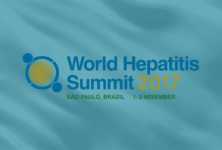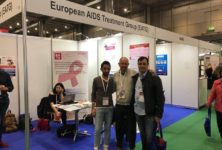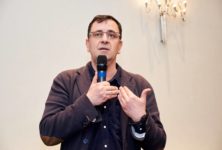Great advances in science often come from outside the direct field of research.
Since the early days of the epidemic, the HIV research community brought together clinicians, virologists, social scientists, and community members to try to shed light on the devastating disease. More than 30 years later, the benefits of interdisciplinary research continue to be valued and will be relevant for emerging efforts to cure or control HIV. Today, there is a growing recognition particularly of the mutually beneficial synergies between HIV research efforts and the cancer research field.
In 2017, a key focus in the field of HIV will be investigating new ways to tackle persistence via interactions and synergies with other fields such as cancer research and immune-based therapies. This will take centre stage when the scientific community convenes in July 2017 at the IAS HIV Cure & Cancer Forum and the 9th IAS Conference on HIV Science (IAS 2017).
In anticipation of the Forum and to begin the New Year, we are sharing some of the most promising areas for which collaboration might prove particularly effective, which include:
- Measuring the burden of disease: Both HIV and cancer cure investigators struggle with the need to quantify the burden of disease. Cancer cells and latently infected memory CD4+ T cells are exceedingly difficult to distinguish from normal cells, and they often reside in tissues that are difficult to access. Intense efforts aimed at quantifying the size and distribution of the disease are ongoing in both disciplines, with often similar approaches being taken. For example, using labelled antibodies or tracers and advanced imaging to detect and quantify these diseased cells is a very active area of investigation in both disciplines. This is particularly important to understand where the diseased cells are and to be able to quantify them.
- Mechanisms of disease persistence: For HIV cure and remission studies, a key goal is to understand how HIV infected cells and cancer cells survive indefinitely. For example, modifications of the genetic environment controlling gene expression (epigenetic modification) are known to be involved in both HIV latency and cancer. Understanding how cells are latently infected, will lead to clues to reverse or permanently enforce latency.
- Mechanisms for immune evasion: In both HIV infection and cancer, the local environment is reshaped to prevent immune mechanisms from clearing the diseased cell. For example, the chronic inflammatory environment, in which both cancer and HIV reside, stimulates a powerful immunosuppressive response that prevents adaptive immunity from clearing the disease. Further insight will help the development of therapies that enhance the capacity of the immune system to target and eliminate virus-producing cells.
- Boosting the immune response through immune checkpoint blockers: The advances in the use of immunotherapy for cancer in the past several years has been remarkable. Indeed, these advances have often been compared with the advances made in HIV disease in the 1990s. Many of the approaches explored in immunotherapy for cancer aim to enhance T-cell function and reduce the immune suppressing inflammatory environment. Specifically, immune check point blockers counteract the “off switch” of some immune cells, and thus boost the cancer-specific immune response, and therefore may work in a similar fashion in HIV. As these drugs have a range of adverse effects, it is hoped that the oncologists will figure out how best to administer these drugs in the clinic.
- Strengthening immune responses: It is possible to boost the immune response by tweaking with the pathways that generate these responses. Other such strategies being explored involve the use of toll like receptor (TLR) agonists, cytokines (such as IL15 and IL21) and dendritic cell targeting vaccination.
- Generating designer T-cells: It is possible to generate designer T-cells that can recognise cancer or HIV proteins. These designer cells are called chimeric antigen receptor (CAR) T-cells and early studies show promising results for some cancers, as these engineered T-cells recognize and kill cancer cells.
- Developing gene-editing tools: Gene therapy is also undergoing radical new developments, using far more precise tools to edit genes. By editing one of the HIV receptors, C-C chemokine receptor type 5 (CCR5), a cell can be made resistant to HIV infection. Gene editing of T-cells has been shown to be safe and current studies are aiming to increase the efficiency, for example by using the CRISPR-Cas9 system both in cancer and HIV cure therapies.
- Altering gene expression: A whole new class of drugs that alter gene expression are being used in addition to chemotherapy for cancer. These new drugs are called epigenetic modifying drugs, which can alter gene expression of both cancer cell and HIV genes. They are being explored to determine if they can reverse latency so that the infected cells become visible to the immune system.
Timothy Brown, the “Berlin Patient”, is the only person known to have been cured of HIV and a well-known example of the potential synergies between HIV and cancer research. Brown was treated by stem cell transplantation for acute myeloid leukaemia, using a donor with a rare genetic mutation which confers resistance to HIV infection (CCR5 Δ32). Following the interruption of antiretroviral therapy, after the transplantation no virus could be detected in Brown.
Clearly, this case is not applicable as a routine therapeutic option for HIV cure, given the complexity and the risks associated with stem cell transplantation. Nevertheless, both cancer specialists and HIV researchers are working together to work out how transplantation can eliminate latently infected cells to inform new and less invasive treatment strategies.
Consistent with sound scientific principles, we must come together this July at the IAS HIV Cure & Cancer Forum and IAS 2017 and learn from each other in this new era of therapeutic advances. We must do everything possible to advance research towards an HIV Cure.
By Françoise Barré-Sinoussi, International AIDS Society Past President and Co-Chair of Towards an HIV Cure, Steven Deeks, Co-Chair of Towards an HIV Cure, Sharon Lewin, Co-Chair of Towards an HIV Cure, and Anna Laura Ross, Towards an HIV Cure Research Consultant.


 ПОИСК ПО САЙТУ
ПОИСК ПО САЙТУ  поиск по ресурсному центру
поиск по ресурсному центру 



